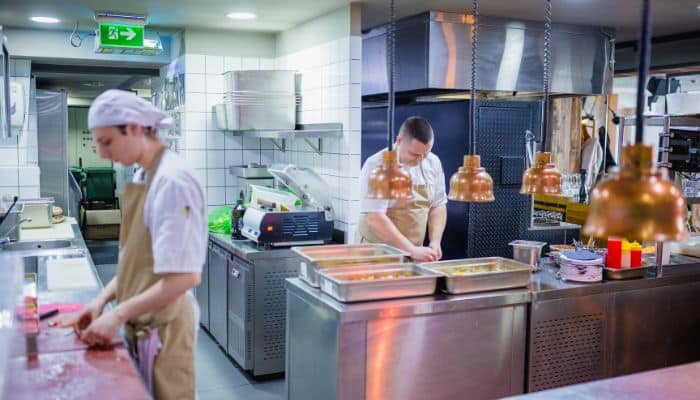From Farm to Fork: Managing Supply Chain Uncertainty in the Restaurant Industry
The supply chain has always been the backbone of the restaurant industry. Without food vendors, restaurants wouldn’t have access to quality ingredients.
Today’s logistics are unlike before, as the supply chain grapples with lost labor, new technologies and substantial shifts in demand. Geopolitics has also contributed to distribution upheaval, posing further risks and stressors.
Restaurants feel the pinch as they learn to manage the new supply chain landscape. They must understand why it lags and how to mitigate disruptions to better adapt and find success.
Current State of the Restaurant Supply Chain
It’s 2023 — the pandemic is under much better control, and businesses are again open. According to the National Restaurant Association, 75% of establishments report near pre-pandemic operations — far better than 96% of restaurants declaring shipment delays and food shortages in 2022.
Despite improvements, restaurants still face regular logistics uncertainty. Part of the issue is labor shortages following COVID-19 lockdowns. Nearly 77% of supply chain professionals plan to leave their jobs in 2023 for career growth, flexibility, higher salaries and better benefits.
While understandable, this industry trend has placed undue pressure on restaurants. Distribution fluctuations have many trying to stay ahead of short inventory, inflation and upset customers while saving money.
6 Ways to Navigate Supply Chain Disruptions
Disruptions in the supply chain have caused more aggravation for restaurants in the last few years than ever before. However, as restaurateurs wait for the dust to settle, they can enhance their supply chain management in these six ways.
Develop a Plan
When facing supply chain uncertainty, restaurants need a backup plan. What happens if one of your primary vendors fails to make a delivery? Who else can you use? Operating with limited inventory for your most popular dishes is one of the worst positions to be in.
A plan should comprise a list of your current suppliers’ contact information and a secondary list of quality backups you can rely on to pick up the slack.
Your restaurant supply chain plan should also assess potential risks and outcomes due to vendor and distributor delays. A risk assessment can help you identify problems before they occur and prepare a resolution in advance.
Foster Stronger Supplier Relationships
A strong supplier relationship can make a world of difference amid logistics uncertainty. Communication is the foundation of success. Opening communication channels ensures everyone is on the same page and prevents mistakes like missing orders.
Supply chain vendors can also participate in effective risk management. Improve transparency to resolve warehouse issues or delayed shipments promptly. Your supplier relationship is a partnership above all else. Finding ways to grow together can help you mitigate problems as they arise.
Improve Budgeting
An uncertain supply chain is more than just about delayed shipments and low inventory levels. Logistics disruptions also drive the cost of goods through the roof.
Restaurants are well aware of the rising costs of staple items. The U.S. Department of Agriculture estimates a 5.8% increase in food prices throughout 2023. Although prices have increased slower than in 2022, restaurants must handle the outlay without hurting their bottom line.
Nearly 56% of Americans do not track their spending. Fortunately, there are apps and programs to help restaurants monitor expenses and stick to a budget.
Modify Your Menu
Part of restaurant budgeting comes down to the menu. Many establishments have scaled back their menus significantly to save money on ingredients and operations.
Nowadays, precision is more important than catering to several taste buds. Menu prices have already increased by 8% in 2022, and experts predict they will increase by another 5% in 2023.
Restaurant owners should track which items customers order the most and remove underpurchased offerings. You can better manage inventory and supply chain issues with a shorter menu of your highest-quality dishes.
Utilize New Technologies
Restaurants can leverage artificial intelligence and other technologies to avoid logistics problems and inventory shortages. Point-of-sale systems are the real showstoppers, tracking orders, payments, inventory, and different front and back-of-house operations.
Other AI technologies deliver automation, real-time data, and analytics to track product purchases and improve efficiency. In turn, restaurants are more productive and work with suppliers to eliminate disruptions.
A new app is also making it easier for restaurants to source quality, affordable ingredients amid supply chain uncertainty. Most distributors hide pricing from customers, but Cheetah creates pricing transparency for wholesale food buyers. Cheetah currently partners with over 3,000 restaurants and has fulfilled roughly 350,000 orders.
Be Transparent
Rising costs may force restaurants to raise their prices — much to customers’ chagrin. Communicating changes with the utmost transparency is vital. However, every establishment must take a different approach.
Some restaurants may increase menu prices without mentioning it to customers. After all, people know inflation has hit restaurants just as hard. Others have taken to social media or new outlets to explain their reasons.
Supply Chain Issues Are Out of Your Control
Restaurants have much to contend with regarding today’s supply chain. However, certain things are out of your control. Therefore, adapting to the changes by improving logistics management is crucial for your establishment to stay afloat.



Comments are closed.